|
|
Post by us4-he2-gal2 on Jul 3, 2008 21:52:35 GMT -5
ah - Right! Thank you Madness. To avoid confusion on first read over, I have amended my post on the relevant comment.
|
|
|
|
Post by us4-he2-gal2 on Jul 4, 2008 0:52:45 GMT -5
I had been reviewing Madness post of June 23 above Naomi so, he knows this picture in Question feature Ninazu because he is accessing Wiggermann's article directly - this is where this picture is featured. A small confusion stems from my discussing Madness post of the 23rd and I had at first mistakenly called this Ningishzida - I have since edited my post with the correct information to avoid further confusion.
Yes it is a complex subject, the details of which probably allude the attention of most in the field of Ancient Near East studies, let alone the public at large. We are at what I think to be the fringes of the examination of these deities - and so the time for consideration of materials gleaned thus far is about right.
|
|
|
|
Post by sheshki on Jul 4, 2008 18:25:23 GMT -5
here is the name of nin-a-zu 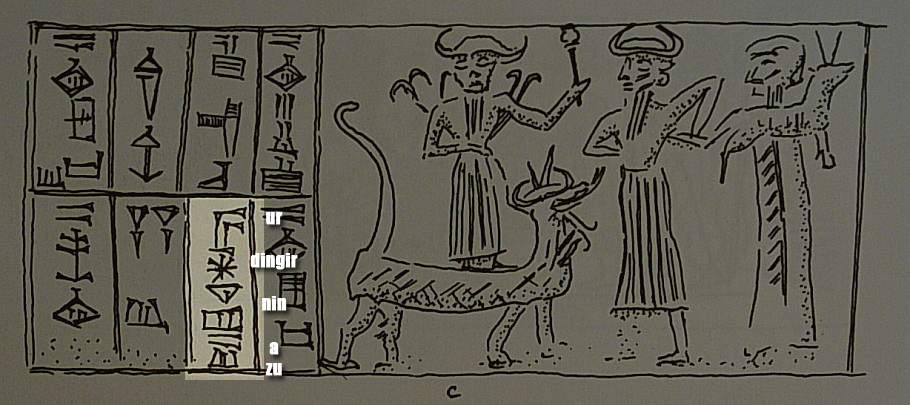 |
|
|
|
Post by sheshki on Jul 4, 2008 18:53:33 GMT -5
btw, if you want to look for yourself, the signs are all on the sign-list at www.enenuru.netthe worlds sexiest signlist...as ush uses to say  |
|
|
|
Post by madness on Jul 4, 2008 22:58:16 GMT -5
The name you have highlighted is Ur-Ninazu. The seal is dedicated to I-ba-um ("Viper") by Be-lí-BAL for his own life and that of his son Ur-Ninazu. How did you figure out the god was NinazuWiggermann compares it to the name of the son and more or less gets his answer that way, and refers the reader to other studies (note 35): On this seal and its iconographical problems see also E. Braun-Holzinger, Mesopotamische Weihgaben der Frühdynastischen bis Altbabylonischen Zeit (1991), 351974, 355 (S 3), and eadem, Der Bote des Ningišzida 38, in B. Hrouda et al. eds., Von Uruk nach Tuttul (FS E. Strommenger) (1991).As for Ningišzida, he buries discussion on the god's relation to the mušhuššu in a single note (70). He happens to analyse Gudea's vase: The name of the entwined dragon-snakes (they have teeth) paired with snake-dragons on Gudea's libation vase has not yet been positively established, but in view of the common pair muš-huš/mušhuššu muš-šà-tùr/bašmu in the texts, the latter is the best candidate.So the entwined snakes are probably bašmu; as for the flanking winged creatures, what he means by "snake-dragons" is mušhuššu, I think [he uses the terms snake-dragon/ mušhuššu interchangeably through his article]. Compare the winged mušhuššu of Ningišzida from the seal of Gudea (number 5) with the snake-dragons on the vase. img49.imageshack.us/my.php?image=2dqs5.jpgwww.dazimua.com/images/enenuru/ceremonialgrail.jpgAnyway, RlA s.v. mušhuššu seems to be the main place to look for further details. The above post may appear thick to some or difficultI thought I made it as straightforward as possible. |
|
|
|
Post by madness on Jul 6, 2008 4:56:14 GMT -5
For curiosity, here is a Neo-Elamite (727-699 BC) cylinder seal, now in the Israel Museum, provided by Mariana Giovino in her 'Assyrian Trees as Cult Objects' in The Iconography of Cylinder Seals. img357.imageshack.us/my.php?image=220hu8.jpgHere we see two mušhuššu dragons standing before a spade (symbol of Marduk) sitting on top of a pole. This scene seems similar to the vase of Gudea. |
|
|
|
Post by us4-he2-gal2 on Jul 10, 2008 10:10:29 GMT -5
The post you've made on July 4th is really quite astounding Madness  The two pictures you've supplied from Wiggermann clearly show that the creatures on the Gudea cup are indeed Mus-hussu, specifically, as depicted in that period (see figure #3 ). This is the first time I've seen it definitivly established. Also- you did put the Transtigiridian material as simply as possible, yet even still it is difficult material. Sheshki - I love this technique of isolating signs in a inscription like this and giving a transliteration. It does indeed read Ur-Ninazu!  |
|
|
|
Post by us4-he2-gal2 on Jul 10, 2008 11:11:38 GMT -5
Comments on a Hymn to Ningishzida I have extracted some comments from Katz 2003 (The Image of the Netherworld in Sumerian Sources), in which the author discusses for us a certain Ningishzida Hymn - See ETCSL t.4.19.11-10. Hero, lord of field and meadow, lion of the distant mountains! Despite the fact that ETCSL have translated KUR here as meaning 'distant mountains', Katz maintains (p.6) that because Ningiszida was primarily a underworld deity, an interpretation of KUR as meaning 'Netherworld ' would be more appropriate in this chapter. She says further: "The first line of the hymn crowns Ningishzida as the lord of the pasture and field. Van Dijk suggested that this might refer to the fields of his temples and, therefore, is not a definitive indication that Ningishzida was a god of vegetation. In addition, since both themes used in the hymn, šà-túm and a-gàr usually signify an arable plot of land, perhaps they refer here to the location of his temple. Ningishzida's association with vegetation is echoed in his name "Lord of the Good Tree." As for the nature of that tree, its noted that some scholars associate Ningishzida, and the tree that is referred to his name, with Viticulture - with the vine. Ningishzida's center Gišbanda has not been located in modern times, its names translates "the young tree." If the idea that Ningishzida's cult was introduced to Southern Mesopotamia is valid, then Gišbanda may be understood as a small cult centre which facilitated this introduction. However viticulture is all but unknown in southern Mesopotamia, and Katz finds it unlikely that the cult was introduced to southern Mesopotamia for that reason Line 2 of this hymn reads " Ninĝišzida, who brings together giant snakes and dragons!" which of course, reinforces his association with snakes. Katz comments here (n.18) that "Ningishzida's association with snakes is already expressed in the god-lists from Fara, where he appears in the circle of Ninpeš." And, referring to the Fara godlist (approx 2600 BC), we do in fact see Ningishzida listed on column 4:
dnin-maš
dnin-PEŠ2(kilin).gi4-lí
dnin-PEŠ2(ašbarx)
dnin-ki-di
dnin-giš-zi-da
dnin-EZEN.AB
dnin-giš-gi
[/color]
|
|
|
|
Post by sheshki on Jul 19, 2008 18:48:59 GMT -5
Jasper cylinder seal and impression: monstrous lions and lion-headed eagles, Mesopotamia, Uruk Period (4100 BC–3000 BC). 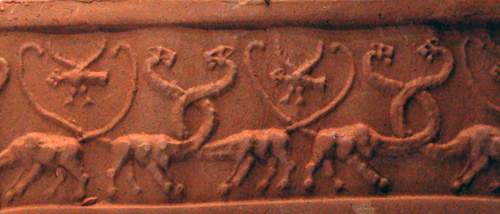 |
|
|
|
Post by sheshki on Jul 19, 2008 19:30:13 GMT -5
i discovered this picture at my harddrive. no idea where its from. it is named DumuziSealUnderworld. the figures left and right to the person in the middle are holding snakes in the same way weve seen before here . 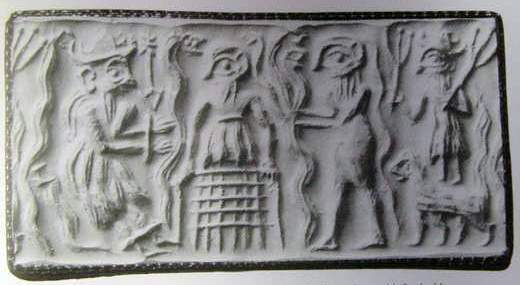 just found the link www.bibleorigins.net/Serpentningishzida.htmlthere is another nice picture concerning snakegods 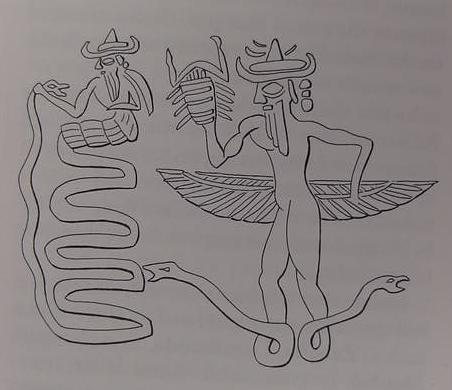 |
|
|
|
Post by sheshki on Jul 19, 2008 19:57:47 GMT -5
Tronconical vase with eversed rim and a flat lip, representing a Master of Animals mastering pairs of entwined snakes. Chlorite, mother-of-pearl and turquoise (?). Found in Tepe Giyan (Khava Valley, near Nehavend, Iran). probably 3rd millenium bc 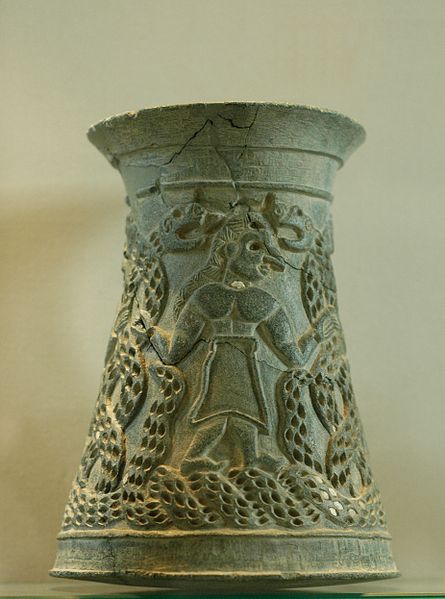 |
|
|
|
Post by sheshki on Aug 3, 2008 16:22:51 GMT -5
|
|
|
|
Post by us4-he2-gal2 on Aug 29, 2008 13:51:09 GMT -5
Although our best and most current information is to be found in the Wiggermann extracts above, I have realized at the library today that I do in fact have access to an article by a women who had been noted for her rare insights into Mesopotamian art and iconography - despite that it is quite dated, will review her article soon.
The God Ningizzida
by E. Douglas Van Buren
Iraq, Vol. 1, No. 1 (Apr., 1934), pp. 60-89
|
|
|
|
Post by us4-he2-gal2 on Sept 21, 2008 20:51:47 GMT -5
Reviewing: The God Ningizzida by E. Douglas Van Buren Iraq 1934 Van Buren was a fairly early name in Assyriology studies and as far I can tell her specialty lay in analyzing Mesopotamian art and in focused discussions of mythological subjects. In this 29 page article her focus is specifically Ningishzida (she prefers the reading rendered by Thureau-Dangin "Ningizzida".) She takes numerous notes, many of which I hesitate to recreate here due to their age - much of the same has been given on this thread which is more clear and more accurate. In other places Van Buren corrects ideas of her fellow scholars of the 1930's; and at other points, her unusual thoroughness brings to the fore unconsidered items I have noted below. Ningizzida's late aspect as exorcist / Pg. 69: van Buren: " It has been suggested that Ningishzidda was originally god of the health-giving plant, the herb of life. Yet the plant which springs from the flowing vase is not peculiar to Ningizzida, and is symbolic of abundant vegetation produced by the fertilizing waters. The crested and crowned serpent was Ningizzida's symbol from very ancient times, and later it was certainly indicative of his curative powers. One incantation text [exorcises] fever and 'every kind of bodily evil'; 'By Ningizzida, guzalû of the wide nether World, mayest thou be exorcised!' This passage has been interpreted to mean that Ningizzida, as a chthonian divinity, received the dead who were delivered over to him by Nedû, the Chief Porter of the Underworld. The reference is not to the dead however, but to the bodily evils which Nedû was adjured to seize and bring down into the land whence there is not return; whereas Ningizzida, in his character of physician, is merely called upon to exorcise them. " van Buren explains that Ningizzida acquired many aspects and late adaptations especially have him fulfilling in some cases the role of exorcist (incedently, the word guzalû relating back to his role as throne bearer of the Netherworld.) (This incantation is found on tablets VAT 13656 + 13657 - T. Abusch supposedly treats it as it is part of a larger ritual in which Gilgamesh presides as important official in the netherworld - the goal of the ritual is to free the patient of witch's and their influence by means of adjuring ghosts to carry the evil off to the Netherworld with them.. The mention of Ningishzida must feature somewhere here, perhaps Madness can find us Abusch's relevant translation?)
Early representations of Ningishzida/ The author states that it is surprising that there are no artistic or literary references to Ningishzida in the time of Lagash (mid-Early Dynastic period) since in that period he is featured in the god-lists. She singles out two depictions which she believes to be early depictions of Ningishzida: however one she refers to has been re-interpreted in recent times by Wiggermann as representing Ninazu and not Ningishzida (see page two of this thread, post 53, #2c.) As for the other, it may yet be an interesting observation for us : Ashmolean Museum, Kish, 1931. 105 van Buren: " The first [representation] came to light during the excavations of the very early levels at Kish, and the style of the figures carved upon it is absolutely typical of the archaic period. The scene divides itself into two groups, the active and the contemplative. The first depicts a god, armed with bow and mace, who climbs the mountains to assault an immense eagle. Beyond the combatants stands another deity holding a tall post, and raising one hand as if to herald the imminent victory. The second group consists of four divinities placed in a row, awaiting with eager interest the result of the fight. The first three stand with clasped hands, the fourth, who must be Ea, holds a vase out of which pour streams of water. Consequently the first three must be deities in close relation to Ea. Flames spring from the shoulders of the first god who must be Gibil, a fire-god and 'Great Messenger of the Gods'; he stands nearest to the fighters in order that he may announce the result of the contest. Ears of corn spring from the sides of the second deity, for this is the most ancient aspect of 'Lord of the growth of the field,' Dumuzi-ab-zu, who here precedes his constant companion Ningizzida, above whose shoulders serpents rear their heads. (Plate IX, a). "**To mention: van Buren's suggestion that the god next to the Archer (second from the right) is to be identified as Gibil the fire god, I believe is incorrect - There are numerous seals depicting the same forked lines from the shoulders, and these are interpreted in recent times as the sun rays of the god UTU. Also, the association between Dumuzi and Ningishzida I believe was later than is this early depiction. Lastly, the deity which she suggests is Ningishzida is forth from the right, unfortunately the picture is very unsatisfactory here - there we need another picture of this seal! still to come.. Further review of van Burens Article!
|
|
|
|
Post by us4-he2-gal2 on Sept 26, 2008 12:39:06 GMT -5
Too little on The Festival of Ningishzida Unfortunately, little is known about the festival of Ningishzida. While we might imagine that there were numerous festivals in his honour at Ĝišbanda, as has been established in earlier posts this locality has not be discovered in modern times and its rites are obscure. What we do have is the above tablet which most likely hails from Lagash and from the Ur III period. The best scholarly source on festivals I have seen is M. Cohen's "Cultic Calanders of the Ancient Near East." This book focuses on those regularly occuring festivals that correspond in large part with significant agricultural events such as the coming of the fertile season and so forth. There are numerous calender's which typically differ only marginally, although in some cases a month is named something in one city and the same month named completely differently in another - festivals dedicated to different deities occur as well. The names of the months typically go back to archaic times, and although some modifications occur, the months and their festivals are inclined toward tradition. So we know that Ningishzida became more important within the Lagash pantheon after Gudea's devotion to him as his personal god; the result may be this festival which we have attested on the tablet pictured above. In truth those tablets which mention festivals are more or less economic tablets: x number of ovines for x temple/deity on x month. Unlike many however, this tablet bears no specification of date of practice, and while we may hope for elaborate instructions and divine hymns and so forth, as Cohen explains, the relevant data that appears on this tablet (in full) reads:
32 gur and 76 liters of barley for the festival of Ningishzida
As gur is a unit of measurement, basically what is called for is a whole lot of barley. So you Ning devotees out there - ah..stock up on barley..? |
|
|
|
Post by madness on Oct 23, 2008 3:36:58 GMT -5
Jacobsen states that, in hymns, Ningišzida is called "Grand Serpent" (muš-mah), and "Terrifying Serpent" (muš-huš). We know what the mušhuššu is, but what about this mušmahhu? In Ninurta's return to Nibru, the storm god describes one of his weapons as "the seven-mouthed muš-mah serpent" (line 138). Black&Green supply us with an Early Dynastic plaque that shows this serpent (p. 165):  |
|
|
|
Post by madness on Oct 24, 2008 0:26:12 GMT -5
For these, Jacobsen cites TCL XV 25, 2; cf. J. van Dijk, Götterlieder II, p. 87, 2. ISET I 187 (pl. 129), Ni 9808 obv. 6, and UET VI/1 70, 4. A perfect example appears in ETCSL 4.19.2 [which is his second cite] etcsl.orinst.ox.ac.uk/cgi-bin/etcsl.cgi?text=t.4.19.2#etcsl.orinst.ox.ac.uk/cgi-bin/etcsl.cgi?text=c.4.19.2&display=Crit&charenc=gcirc#Here Ningišzida is described as a "howling mušhuššu" and as an " ušumgal-dragon snarling in the lagoon." Lines 8-15 are especially interesting. In the 3 different versions of line 8 there is a play on words between muš, maš, maš-maš, mah, and uš 11His mouth is that of: A pure magician: maš-maš maš A snake with a great tongue, a magician: muš eme mah maš-maš mah A poisonous snake: muš uš 11The following lines continue to play on words in an alliterative style, focussed on the syllable zu "wisdom/knowing," a cumulative effort that ultimately realises Ningišzida's power as a mušhuššu (line 15: "When your great word comes to the earth, you are indeed a great mušhuššu ..."). |
|
|
|
Post by us4-he2-gal2 on Oct 28, 2008 13:41:51 GMT -5
Madness: This is a wonderful bit of explanation concerning the muš-mah - thanks very much! This bit of obscurity could not be more effectively put, and is fascinating for us Ningishzida enthusiasts ;]
Reviewing: Offerings to Ningishzida from: The God Ningizzida E. Douglas van Buren, Iraq 1934 This week I am back at the library looking at van Buren's rather large article once more. Of the numerous possible topics I am looking at her discussion on the offerings made to Ningishzida so far as records from different temples of different locals can best inform us. There are obviously limitations to the information available here and it will pertain to the activities of the temple cult over those of the common Sumerian. Van Buren had also given some description of temples which worship Ningishzida, however that information overlaps mostly with reply #2 earlier in this thread. In Lagash/ Gudea: The author first refers to the well known offerings of Gudea to Ningirsu. These include the often referred to Gudea cup. She also mentions that many objects were found withing the temple of Ningishzida at Girsu, including the cover of a lamp ornamented with two intertwined serpents and "scattered around everywhere within the precinct were clay boxes and covers decorated with serpents in relief; on one four serpents drink from a bowl, perhaps to intimate that the drink-offering was accepted by the god." In addition a Stone macehead with an inscription to Ningishzida was found in the Girsu sanctuary. Also three statues of Gudea with inscriptions honor Ningishzida are mentioned. In Ur/ The Ur III king named Ur-Nammu had a Hymn composed which includes information on what he offered various deities. As van Buren recounts the section dealing with Ningishzida's offerings is unfortunately broken, but the lines that do survive indicate that Ur-Nammu made substantial offerings to this god. They read:
33. To the shepherd, the pastor who...,
34. The might, the valiant Ningizzida,
35. The shepherd Ur-Nammu in his palace offered.
The author makes mention of an Ur tablet which states that butter, dates and cheese were to be provided for Nin-gi-zi-da of Uru.KI. A text which must hail from Ur and is dated reign of Amar-sin reads: "Six grain-fed sheep to the god Nannar, one grain-fed sheep to the Great Treasurer (= Ea), one grain-fed sheep to the god Nin-da-iz-zid-dim." (= Ningishzida). Lagash in the Isin/Larsa period/ Some specific cultic ordnances are given in a few economic texts some 300 years after Gudea. One reads: ' In the 7th month of [Shu-sin] four sheep and one goat were brought to the temple of Ningishzida' In addition to animal offerings, inanimate objects were offered as is mentioned "there is a receipt for six pots of fragrant herbs from Ninga, received at the temple of Ningishzida." The author adds "It was ordained also that butter, dates and cheese should be provided for Ningishzida and other gods at Lagash and elsewhere. Babylon/ "At Babylon the records of offerings are very scanty; one tablet speaks of libations at the temple of Ningishzida, a second ordains that a sheep and a goat should be offered to him; apparently these sacrifices were accompanied by lamentations." In Eshnunna/ "Several tablets reveal the fact that at Eshnunna Ningishzida was one of the gods to whom sacrifices were made, and one tablet summarizes offerings 'for the house of Tishpak, for Ningizzida, and for Enlil'." Administration at the Ur III period Girsu Temple Van Buren concludes her article with a look at the Officials and Administration in E- dNingishzida temple at Girsu (Ur III period.) This information is made possible by the discovery of a tablet which gives the payroll for each member of the functionaries at that temple. I have copied the author's list of staff below, unfortunately due to the age of this article, this list may contain outdated spellings. In the Ningishzida temple at Girsu, there were:
4 šabra (officials)
8 nubanda-gud
2 pisan-dubba
2 sagtu
2 ka-gur
1 dubsar-gud-apin
1 sarrubdu
2 nubanda-erin-na
1 lu-sar
1 maškim
8 guzala2
42 engur
Each member of the temple staff had their own task according to the hierarchal scheme employed. The sabra (sanga?) most likely were the temple administrators while nubanda-gud the author explains were overseers of oxen; the dubsar-apin-na most likely was some sort of scribe while the maškim was a type of bailiff and so on. Van Buren concludes: "This elaborated organization implies that Ningishzida's temple possessed large revenues in kind, and extensive tracts of land which were cultivated for the benefit of the land. Numerous texts confirm these surmises. There is a comprehensive account of certain fields leased out to farmers who were obliged to bring in stated amounts grain in payment." The temple owned and leased fields therefore, the ones owned by this temple being known as the fields of Ningishzida. This information is in theme and in terms of its sources (economic texts from Lagash/Girsu) very similar to the material that lead A. Deimel to propose his "temple-state hypothesis" in the early 1900s. According to this theory, land in early Sumer could be exploited efficiently only if it was considered property of the gods, rather than individuals or families - later this form of land governance was outmoded by increasing state organization. |
|
|
|
Post by madness on Nov 7, 2008 2:55:56 GMT -5
That snakes symbolise sexuality is indicated in a Neo-Assyrian mystical explanatory work, where the various parts of the body of a deity* are equated with plants, fruits, animals, objects, etc.
On line 3: "His penis is a snake."
* The deity is not named (probably lost in the lacuna at the beginning). A similar text gives the epithet dkár.kár "the shining one." This is usually a name of Šamaš, but could be used to describe other gods. Livingstone explains: "Stunning brightness has been noted as a general characteristic of descriptions of Mesopotamian gods. It is suggested that by choosing Karkar rather than a well known name of a deity the author aimed for generality."
|
|
Mela
dubsartur (junior scribe)

Posts: 5
|
Post by Mela on Nov 28, 2008 14:20:16 GMT -5
Wow is all I can say for Now ! I have been researching Ng for a few years via Abrahadabra and other forums Im familiar with the "Basics" This is loads of new info to work with  I did not know much facts about this diety but has strangely enough been contacted by him several times via dreams and visions. since I was a teen. Not in a romatizised way but rather in a way some-where between shits-cared and euphoric. Excuse my English its not y first language. He has showed me so many dimension and densities both outside and Inside of my self. And enlightened me in ways I did not Imagine Possible. A very Complicated Love affair ;-) |
|
|
|
Post by us4-he2-gal2 on Nov 29, 2008 9:38:53 GMT -5
Hellow Mela: Nice to meet you - you have sort of a introduction post and comment on the Ningishzida thread in one there, but that works. Well there is alot we have sort of amassed here on this deity, unfortunately it is not arrange and compressed into one presentation but is hapzardly posted as we find new bits of information and better and better scholarship. In order to really make sense of it, some introduction to Mesopotamian studies may be needed, and if you are looking to attain that as well, feel free to msg me and I can mention some strategies. cheers  |
|
Mela
dubsartur (junior scribe)

Posts: 5
|
Post by Mela on Nov 29, 2008 15:43:43 GMT -5
Thank you very much Im sorry I forgot to Introduce My self Properly
My name is Mela and Im a Metaphysical Researcher a Sexual Healer and Spiritual Councelor
as a Priestess I have come across some of the Concepts mentioned here but in a very Spiritual way The reason I decided to find more Facts is because there is so much Spiritual and Factial miss information out there It almost seems like the more Spiritual People get the more they forget about making References ;-0 lol
When im not Being a Spiritual Nutter I work with the Black Community from an Outreach centre in South London I have been doing Outreach for 4 years now and will Move to Jamaica and start a small Community Centre in March.
Im gonna take a few days to read and Digest the Info I have come across here.
One Love !
|
|
|
|
Post by madness on Dec 5, 2008 23:34:07 GMT -5
See reply #53 with figure 4b.
|
|
|
|
Post by madness on Dec 7, 2008 0:42:18 GMT -5
It is an Akkadian era cylinder seal. That is, from some time during the second half of the 3rd millennium BC. The deity in figures 4b and 4d that has an anthropomorphic torso but a winding snake for a lower body* is identified by Wiggermann as Ištaran. However, McEwan [in OrNS 52] tentatively identifies this figure as Nirah/Irhan, the messenger of Ištaran, but this would leave the identity of the master open and give a servant god the iconography of an independent lord.dNirah and dIrhan are both written dMUŠ. Nirah is the deified snake and Irhan is the deified river Euphrates (represented as a snake). A little bit of ambiguity, as although Nirah/Irhan is usually the son and messenger of Ištaran, in a late text Nirah/Irhan and Ištaran are equated as one. Nirah/Irhan is also associated with Ningišzida and Enki. I do not know the identity of the scorpion-handed deities in figure 4b. Elsewhere Ninazu/Tišpak appears with a scorpion hand, but I cannot say whether that applies here. Next time I am at the university I will take a look at McEwan's study, which deals with dMUŠ in depth, as the library has every single volume of Orientalia Nova Series. * Just so we are clear, I am talking about this deity: img67.imageshack.us/my.php?image=snez7.jpg |
|
|
|
Post by madness on Dec 10, 2008 21:17:43 GMT -5
More on Nirah:
Wiggermann remarks [ Mesopotamian Protective Spirits p. 151 ] that
Yet even in the Akkad period not all gods were completely or only anthropomorphic ... A snake god with human upper body is well known from Akkadian seals, but later disappears, probably because he shed the snake part. There is reason to believe that he is the city-god of Der, Ištaran, and that the snake part became his symbolic animal, Nirah.
This partial anthropomorphism occurs with the other snake gods: they develop out of their symbolic animal (or vice versa, however you want to look at it). It could be seen that the deity is both Ištaran and Nirah, eventually splitting into two separate figures.
Nirah is the vizier of Ištaran. Wiggermann's explanation that the ophidian character of a snake god is embodied by his vizier gives me the impression that a vizier is an extension of the master, rather than a distinct deity.
|
|
|
|
Post by sheshki on Dec 11, 2008 20:12:43 GMT -5
In a post Xuchilpaba made is a drawing of a cylinderseal impression.There you can see, at the right side of Inanna , a Mushhushu dragon holding a post, just like at the gudea vase. 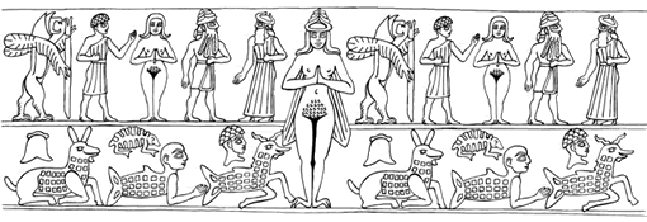 |
|
|
|
Post by sheshki on Dec 12, 2008 19:08:18 GMT -5
|
|
Mela
dubsartur (junior scribe)

Posts: 5
|
Post by Mela on Dec 14, 2008 11:22:36 GMT -5
Blessed Love I came across some information regarding the Eight Pointed star that appears to the right of the Snake God. The Sumerians used an arrangement of lines as a symbol for both star and God. The linear eight-point star represented the goddess Inanna, Sumerian queen of the heavens and Ishtar (Astarte), the Babylonian goddess known as “The Lightbringer.” An eight-point star enclosed within a circle was the symbol for the sun god. The “Babylonian star-cult is the core and the archetype of subsequent astrology.” moroccandesign.com |
|
|
|
Post by sheshki on Feb 4, 2009 21:54:36 GMT -5
Image from a documentary about mesopotamia a sumerian hero type holding two snakes 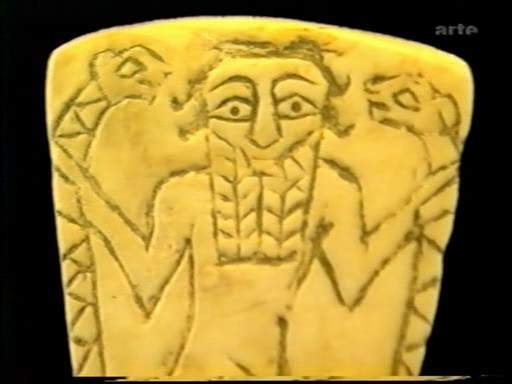 |
|
|
|
Post by sheshki on Feb 11, 2009 6:59:46 GMT -5
Incised stone (?) amulet against the demon Pazuzu from Ashur / Assur, 1st half of the 1st mill. BC. Vorderasiatische Museum, Berlin. 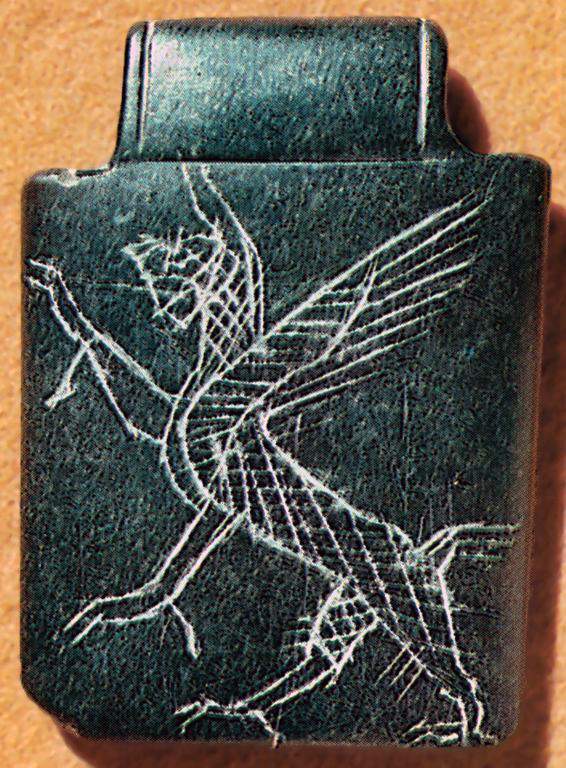 |
|